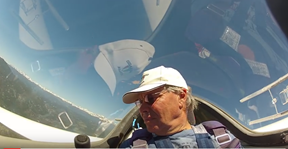Say No to Closing Boulder Airport
Bob Yates, a mayoral candidate for Boulder Colorado, wrote this excellent article in the Boulder Bulletin on the consequences of closing Boulder’s 96 year old airport.
Bob Yates, a mayoral candidate for Boulder Colorado, wrote this excellent article in the Boulder Bulletin on the consequences of closing Boulder’s 96 year old airport.
For 96 years, the Boulder airport has served the entire community and saved thousands of lives in the fight against wildfires, flood events, and everyday emergencies. Now, a group of vocal anti-airport activists wants to destroy it to replace it with dense urban housing developments.
This would be a terrible mistake. Closure of our airport would:
In the long term:
What you can do:
Please visit saveboulderairport.com
Find out why the airport is indispensable to our community and sign our short grassroots petition. It won't take you a minute.
Please help protect this irreplaceable resource!
 The Soaring Society is participating in Boulder's bi-annual Airport Day and Open House on Saturday 6/18/2016 at Boulder Municipal Airport.
The Soaring Society is participating in Boulder's bi-annual Airport Day and Open House on Saturday 6/18/2016 at Boulder Municipal Airport.
This is a free event, from 9 a.m. to 3 p.m.,featuring other aircrafton including World War II planes, firefighting aircraft, helicopters, antique airplanes and more.
For more information The Soaring Society is participating in Boulder's bi-annual Airport Day and Open House on Saturday 6/18/2016 at Boulder Municipal Airport.
Here's a video captured over our ex club president, Elliot Crawford, taking a local reporter for a glider flight.
Fire or Flood ... When its time to serve our community, Boulder airport steps up.
--During the Four Mile fire, Boulder Airport was turned into an essential firefighting station. Extremely large and heavy helicopters operated in high tempo operations going on direct lines to the fire and local lakes at low altitudes continued for days. It is likely that hotel residents and owners would not be comfortable directly under such high tempo, very high noise profiles, and in close proximity to potentially dangerous operations. Compromising such critical operations to accommodate a hotel and it's guests is not likely to be a welcome solution to Boulder residents threatened by future fires.
--Likewise, during the Great Flood, the Boulder Airport was turned into a command and transportation center for rescue operations. Like during the Four Mile fire, high intensity, large helicopter operation continued for days. It is inevitable that hotel occupants and owners would not like being exposed to high intensity, noisy and sometimes hazardous operations.
--When strong west winds exist, a not uncommon occurance in Boulder, aircraft of ALL TYPES departing to the west experience significant turbulence and down drafts. A large building in the proposed location will likely increase turbulence and unpredictable wind currents. Currently it is VERY common to experience down drafts on departure which can result in low level flight in the vicinity of the proposed hotel, increasing risk to hotel occupants..not to mention the pilots and passengers in departing aircraft. An increase in low altitude flight and unpredictable flight paths over the proposed hotel must be considered. Currently there are no structures in this area to be put at elevated by these adverse wind conditions.
--Experience across the nation shows that as high occupancy structures are built near long existing airports, the occupants complain of noise..regardless of their awareness of an airport
Existing there for years. In many documented cases, political pressure results in closure of the airport. It is entirely reasonable to expect the same effort in Boulder..especially considering prior efforts to close the air port. As the community considers building high density structures close to the long existing airport, it must consider the loss of federal money that flows into the community, the essential services performed there, and the value to business both at the airport and in the community.
The Arapaho Peaks Soaring Area provides airspace for high altitude glider flights. The attached graphic shows its extents.
